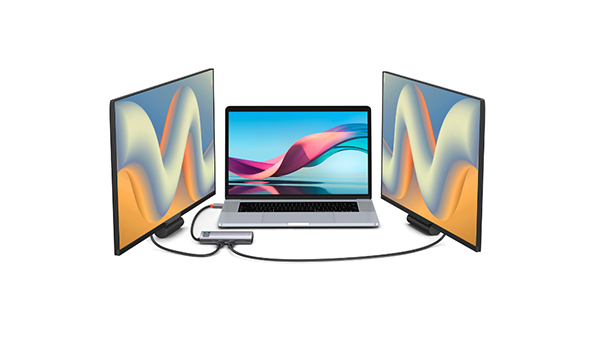How To Connect 2 Monitors To A Laptop?

In today’s fast-paced and multitasking world, having just one monitor for your laptop might not be enough. Whether you’re a professional looking to increase productivity or a gamer seeking a more immersive experience, connecting two monitors to your laptop can open up a world of possibilities. In this article, we will explore the various methods and tips for successfully connecting two monitors to a laptop, so you can take your computing experience to the next level.
Related: Best & Cheap Laptop Repair Service in Oman
Setting up Multiple Monitors: Enhancing your Laptop Display
In today’s digital age, having a single laptop display can sometimes feel limiting. Whether you’re a multitasking professional or a passionate gamer, setting up multiple monitors can greatly enhance your laptop display and boost your productivity. With the right hardware and software configurations, you can create a seamless and immersive workstation that allows you to work efficiently and enjoy your favorite content on a larger scale.
Related: Best & Cheap Laptop Repair Service in Oman
To connect two monitors to your laptop, you’ll first need to check if your laptop supports multiple displays. Most modern laptops come equipped with at least one HDMI or VGA port, which allows you to connect an external monitor. If your laptop has multiple ports, you’re in luck! You can easily connect two monitors by using a combination of HDMI, VGA, or DisplayPort cables. To connect the monitors, follow these steps:
- Identify the available ports on your laptop: Look for HDMI, VGA, or DisplayPort ports on your laptop. Make sure you have the necessary cables to connect your monitors to these ports.
- Choose the right cable: Depending on the ports available on your laptop and monitors, select the appropriate cable. For example, if your laptop has an HDMI port and your monitors have HDMI ports, use an HDMI cable for a seamless connection.
- Connect the first monitor: Plug one end of the cable into your laptop’s port and the other end into the corresponding port on the first monitor. Ensure a secure connection.
- Connect the second monitor: Repeat the previous step to connect the second monitor to your laptop. Make sure to use a different port on your laptop and the corresponding port on the second monitor.
- Configure your display settings: Once both monitors are connected, you may need to adjust your display settings to extend or duplicate your laptop’s screen onto the additional monitors. On Windows, you can do this by right-clicking on the desktop and selecting ”Display settings.” On Mac, go to ”System Preferences” and click on “Displays.”
With your multiple monitors set up, the possibilities are endless. You can now enjoy a larger workspace for your work tasks, have multiple windows open simultaneously, or immerse yourself in a gaming experience like never before. Explore the power of multiple monitors and take your laptop display to new heights!
Understanding the Hardware Requirements: What You’ll Need for Dual Monitor Setup
To successfully connect two monitors to your laptop, it’s essential to understand the hardware requirements involved. With dual monitor setup, you can enhance your productivity, multitasking capabilities, and overall computing experience. So, let’s delve into what you’ll need to make this setup a reality.
- Graphics Card: One of the most crucial components for a dual monitor setup is a capable graphics card. Make sure your laptop has a dedicated graphics card or an integrated one that supports multiple displays. Check the specifications of your laptop or consult the manufacturer’s website to ensure compatibility.
- Video Output Ports: Your laptop needs to have the necessary video output ports to connect two monitors. The most common ports used for this purpose are HDMI, DisplayPort, and VGA. Identify the available ports on your laptop and ensure they match the input ports on your monitors.
- Adapters and Cables: Depending on the video output ports of your laptop and the input ports of your monitors, you may need adapters or cables to establish the connection. For example, if your laptop only has HDMI ports but your monitors have VGA ports, you’ll need an HDMI to VGA adapter or cable.
- Monitor Stand or Mount: To optimize your dual monitor setup, consider using a monitor stand or mount. This will help position your monitors ergonomically, providing a comfortable viewing experience while maximizing desk space.
- Power Supply: Dual monitors require more power than a single display, so ensure that your laptop has a sufficient power supply. If necessary, connect your laptop to a power outlet to avoid draining the battery quickly.
In conclusion, connecting two monitors to your laptop requires a compatible graphics card, the right video output ports, adapters or cables, a monitor stand or mount, and an ample power supply. By understanding these hardware requirements, you can successfully set up a dual monitor configuration that enhances your productivity and enriches your computing experience.
Step-by-Step Guide: Connecting Two Monitors to Your Laptop
Connecting two monitors to your laptop can greatly enhance your productivity and multitasking capabilities. With just a few simple steps, you can expand your screen real estate and create a more efficient working environment. Follow this step-by-step guide to learn how to connect two monitors to your laptop.
First, check the available ports on your laptop. Most modern laptops come with at least one HDMI or DisplayPort and one VGA or DVI port. If you have two HDMI or DisplayPort ports, you’re in luck as these are the easiest to work with. If not, don’t worry, you can still connect two monitors using a combination of ports.
Once you’ve identified the ports, connect the monitors to your laptop using the appropriate cables. If you have two HDMI or DisplayPort ports, simply connect each monitor using a separate cable. If you have different types of ports, you’ll need to use an adapter or a docking station to make the connections. Make sure the monitors are plugged into a power source and turned on.
Now, it’s time to configure the display settings on your laptop. Right-click on your desktop and select “Display settings” from the drop-down menu. In the display settings window, you’ll see a diagram representing your monitors. Click on the “Detect” button to identify the connected monitors.
Once the monitors are detected, you can choose how you want them to be arranged. You can select “Extend these displays” to have an extended desktop across both monitors, or “Duplicate these displays” to mirror your laptop screen on both monitors. You can also drag and rearrange the monitors in the diagram to match their physical positions.
In addition to adjusting the arrangement, you can also customize the resolution, orientation, and scaling of each monitor. This allows you to optimize the display settings according to your preferences and the capabilities of your monitors.
By following these simple steps, you can easily connect two monitors to your laptop and enjoy a more efficient and productive workspace. Whether you’re working on multiple projects, multitasking between applications, or simply want a larger screen for entertainment purposes, dual monitors can greatly enhance your computing experience. So go ahead and give it a try!
Optimizing Display Settings: Getting the Most Out of Your Dual Monitor Setup
Connecting dual monitors to a laptop can greatly enhance your productivity and overall computing experience. With two screens, you can have multiple applications and windows open at the same time, making it easier to multitask and access information quickly. However, to truly optimize your display settings and get the most out of your dual monitor setup, there are a few key steps you need to follow.
1. Check your laptop’s video output ports
Before connecting your monitors, you need to identify the video output ports available on your laptop. Common types include HDMI, DisplayPort, and VGA. Make sure your laptop has at least two video output ports that match the connectors on your monitors.
2. Connect the monitors to your laptop
Once you have identified the video output ports, you can connect your monitors to your laptop. Use the appropriate cables and connectors to establish a physical connection. Ensure that both monitors are properly plugged in and turned on.
3. Adjust the display settings
After connecting your monitors, you will need to adjust the display settings to ensure they are working together seamlessly. Here are a few settings you should consider:
- Screen resolution: Set the resolution to the recommended level for each monitor to ensure clear and sharp visuals.
- Orientation: Choose whether you want your monitors to be aligned horizontally (extended desktop) or vertically (mirrored).
- Arrangement: Arrange the position of your monitors based on their physical placement to match your workspace setup.
- Scaling: Adjust the scaling options to ensure that text and icons appear in the right size on both monitors.
By following these steps and optimizing your display settings, you can maximize the potential of your dual monitor setup. Enjoy the increased screen real estate and productivity boost that comes with having two monitors connected to your laptop!
To Wrap It Up
In conclusion, connecting two monitors to a laptop can greatly enhance your productivity and multitasking capabilities. Whether you’re a professional needing the extra screen space for work or a gamer looking to expand your gaming experience, the process of setting up dual monitors is easier than you may think. By following the steps outlined in this article, you can take your laptop setup to the next level and enjoy the benefits of a dual-monitor display. So, why settle for one screen when you can have two? Happy connecting!



